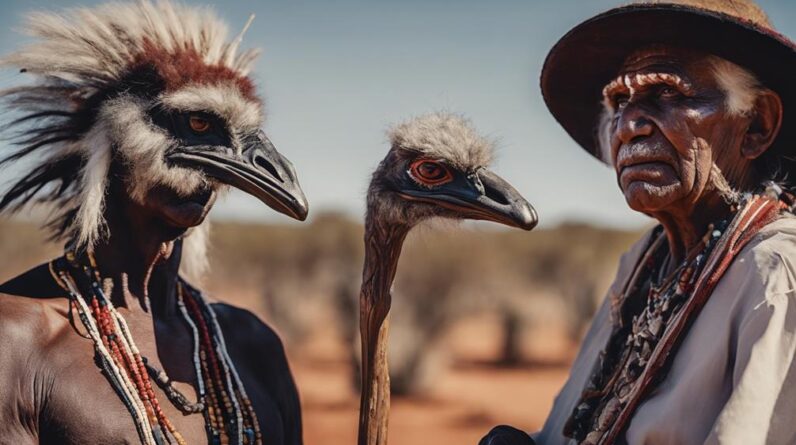
Emus, emblematic in Aboriginal Australian culture, embody a multifaceted significance that stretches beyond the surface. From Dreamtime narratives to intricate dance rituals, these flightless birds play a pivotal role in various aspects of indigenous traditions.
Exploring the intricate connection between emus and Aboriginal spirituality, art, and daily life unveils a rich tapestry of cultural heritage waiting to be unraveled.
Key Takeaways
- Emus symbolize unity, strength, and spiritual connection in Aboriginal Australian culture.
- Emu feathers hold deep spiritual significance and are used in ceremonies for protection and healing.
- Emus play a vital role in traditional practices, embodying resilience and cultural heritage.
- Conservation efforts blend traditional ecological knowledge with modern science to safeguard emus and their cultural importance.
Emus in Dreamtime Stories
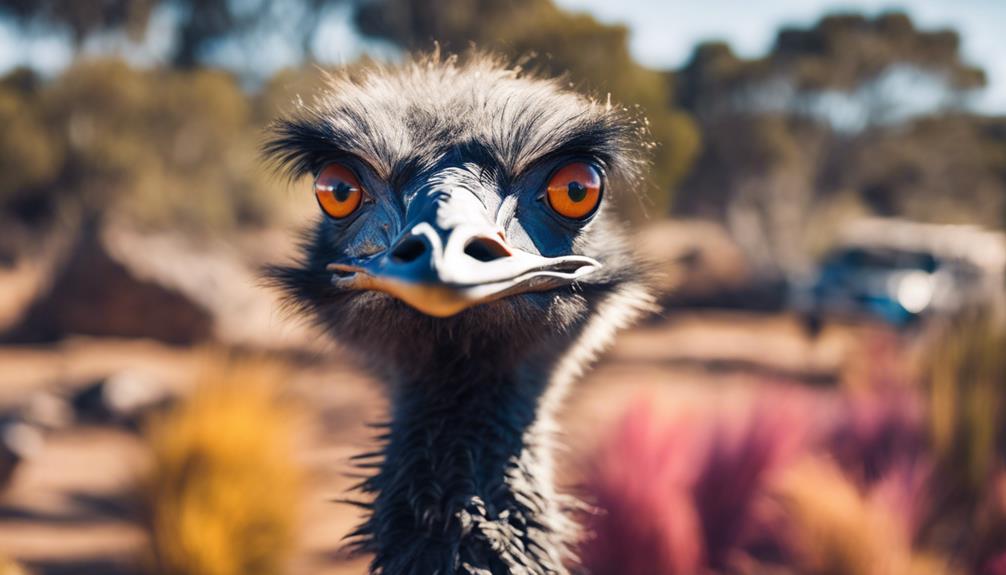
Emus play a significant role in Aboriginal Dreamtime stories, serving as key characters in the rich cultural narratives passed down through generations. These stories aren't merely tales but are deeply intertwined with Indigenous spirituality, carrying profound meanings and teachings. In Dreamtime stories, emus are often depicted as wise and cunning creatures, embodying important values like perseverance, resourcefulness, and respect for the land.
Within Indigenous spirituality, emus symbolize more than just physical beings; they represent a connection to the land, ancestors, and the spiritual world. The graceful movements of the emu are believed to mirror the dance of creation, reminding the Aboriginal people of their place in the intricate web of life. Through these stories, Aboriginal communities pass on knowledge about survival, adaptation, and the importance of living in harmony with nature.
Emus in Dreamtime stories serve as metaphors for navigating life's challenges, respecting traditions, and honoring the interconnectedness of all living beings. By delving into these narratives, one can gain a deeper appreciation for the profound wisdom embedded in Aboriginal culture.
Symbolism in Aboriginal Art
In Aboriginal art, intricate symbols and motifs are skillfully woven together to convey deep cultural meanings and stories that have been passed down through generations. Aboriginal art is rich in symbolism, with each symbol carrying a specific significance that contributes to the overall narrative depicted in the artwork. These symbols are not merely decorative but serve as a visual language, communicating complex ideas and spiritual beliefs. The art reflects the interconnectedness of the Aboriginal people with the land, animals, and ancestral beings.
| Symbol | Meaning |
|---|---|
| Emu Tracks | Representation of travel and the search for food |
| Water Holes | Symbolizes life, nourishment, and spiritual renewal |
| Campfires | Signifies community, gatherings, and storytelling |
| Dreamtime Stories | Depiction of creation myths and cultural heritage |
Aboriginal art serves as a powerful medium for storytelling and cultural preservation, bridging the past with the present. The intricate patterns and symbols carry the wisdom, history, and spirituality of the Aboriginal people, inviting viewers to delve into a world where every stroke is imbued with meaning and significance.
Emu Hunting Traditions
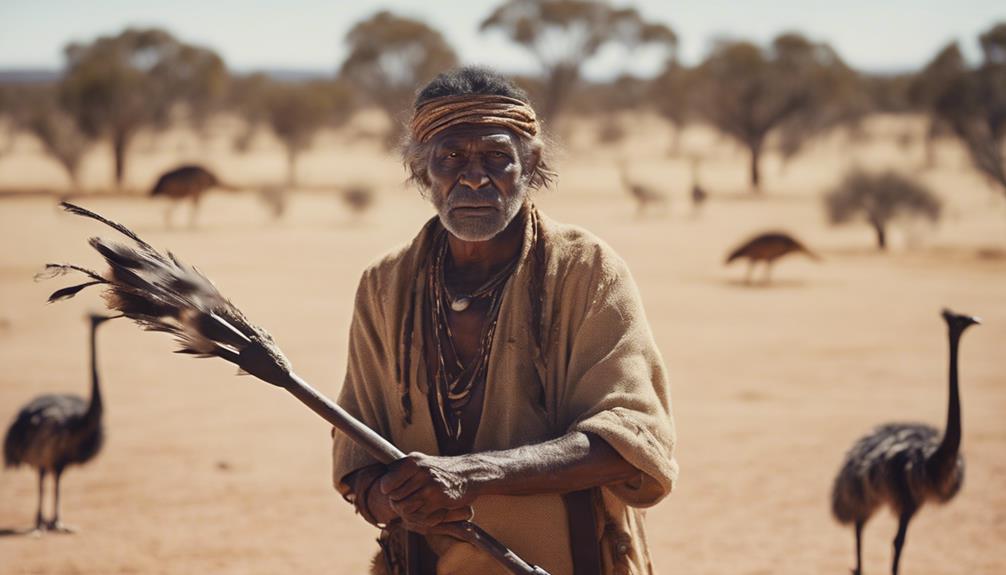
Emu hunting traditions among Aboriginal communities embody a deep-rooted connection to the land and a profound respect for the natural world. When engaging in emu hunting, Aboriginal Australians utilize intricate tracking techniques passed down through generations to locate these majestic birds. Preservation methods play a crucial role in ensuring that every part of the emu is utilized respectfully, in line with cultural practices.
Emu meat preparation is a labor-intensive process that involves traditional methods focused on honoring the animal's spirit and ensuring no part goes to waste. Hunting tools such as spears and boomerangs are skillfully crafted, reflecting the deep understanding and respect for the environment held by Aboriginal hunters.
Through these traditions, Aboriginal communities not only sustain themselves but also maintain a spiritual connection with the land and the emu, fostering a harmonious relationship between humans and nature.
Spiritual Significance
Within Aboriginal Australian culture, the emu holds a profound spiritual significance that permeates various aspects of traditional practices and beliefs. Emus are revered for their connection to the land and the Dreaming, embodying spiritual teachings passed down through generations.
Ritual practices often involve emu feathers, which are considered sacred due to their association with the bird's symbolism of wisdom and guidance. Emu feathers are used in ceremonies to invoke protection, strength, and to connect with ancestral spirits.
The spiritual significance of emus is also evident in sacred ceremonies where their presence is believed to bring blessings and divine messages. These ceremonies are deeply rooted in the belief that emus carry the wisdom of the land and serve as messengers between the physical and spiritual realms.
Emus aren't merely birds in Aboriginal Australian culture; they're revered beings that play a vital role in upholding spiritual traditions and connecting the community with their ancestors.
Emu Dance Rituals
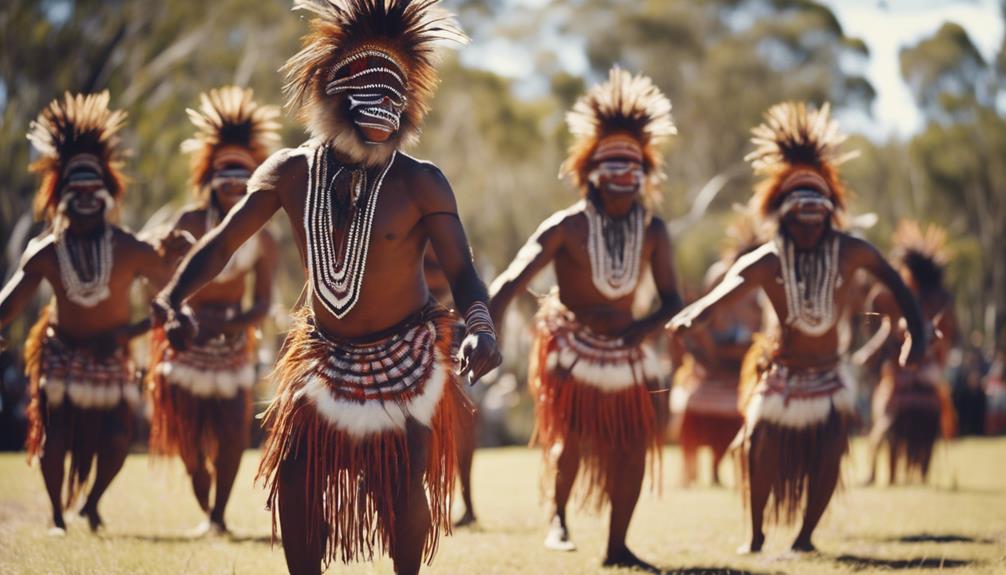
Emu Dance Rituals
Amidst the rhythmic beats of traditional music and the flickering glow of ceremonial fires, the Emu Dance Rituals captivate participants and spectators alike with their mesmerizing movements and deep cultural significance. The dance embodies a connection to the land, ancestors, and the spirit of the emu, creating a profound experience for those involved.
- Emu Dance Techniques: The intricate footwork and arm movements imitate the emu's graceful yet powerful strides, showcasing the dancers' agility and strength.
- Cultural Significance: The Emu Dance Rituals serve as a way to pass down stories and traditions through movement, preserving cultural heritage for future generations.
- Ritualistic Emu Movements: Each step, each sway, is a symbolic gesture that honors the emu as a spiritual being and guardian of the land.
- Performance Art: Beyond a mere dance, the Emu Dance Rituals are a form of storytelling, a spiritual practice, and a visual spectacle that embodies the essence of Aboriginal Australian culture.
Connection to Ancestors
As the Emu Dance Rituals unfold, a palpable sense of connection to ancestors permeates the atmosphere, weaving threads of heritage and spirituality into the movements of participants. The ancestral connections felt during these rituals are deeply rooted in the cultural significance of the emu within Aboriginal Australian traditions. Through the dance, individuals honor their forebears, embodying the wisdom and experiences passed down through generations. This connection to ancestors is not merely symbolic; it is a living, breathing essence that guides and shapes the present moment.
—
| Ancestral Connections in Emu Dance Rituals | ||
|---|---|---|
| *Enhances spiritual connection* | *Strengthens cultural identity* | *Honors the wisdom of ancestors* |
| *Fosters a sense of belonging* | *Transmits historical knowledge* | *Upholds traditional values* |
| *Deepens respect for heritage* | *Promotes intergenerational bonds* | *Preserves ancestral legacy* |
Emus in Contemporary Indigenous Life
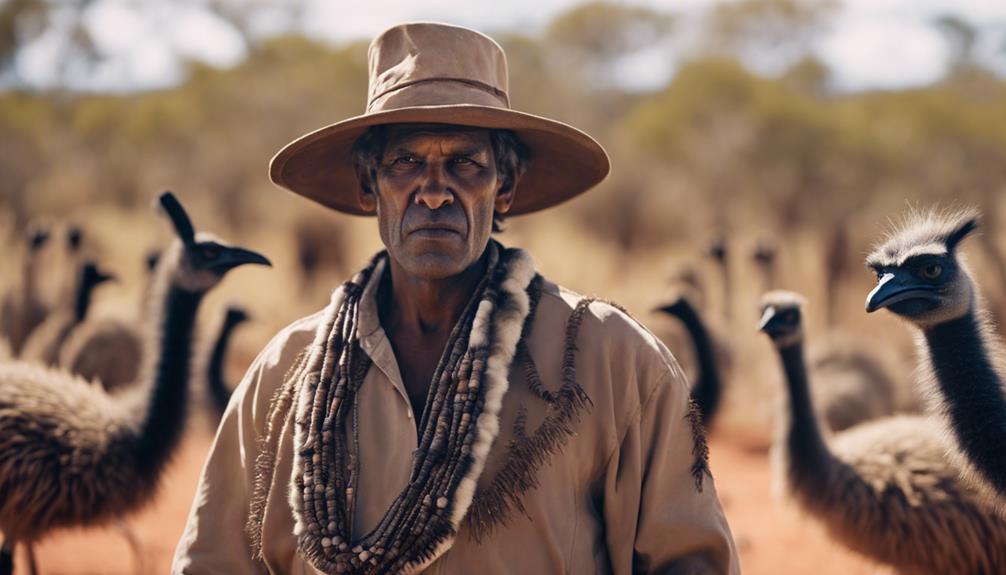
How do contemporary Indigenous communities integrate emus into their daily lives, preserving cultural heritage while adapting to modern challenges? Emus hold a significant place in the hearts of Indigenous peoples, not just as a cultural symbol but as a practical resource. Here's how emus continue to play a vital role in contemporary Indigenous life:
- Emu farming practices: Many Indigenous communities have embraced emu farming as a sustainable way to reconnect with their traditional practices while also creating economic opportunities.
- Indigenous perspectives: Emus are seen as more than just livestock; they're respected beings that hold spiritual significance in many Indigenous belief systems.
- Emu meat consumption: The consumption of emu meat isn't merely a dietary choice but a way to honor cultural beliefs and maintain a connection to the land.
- Cultural beliefs: Emus are woven into various aspects of Indigenous culture, from storytelling to ceremonies, keeping traditions alive in a rapidly changing world.
Emu Feather Symbolism
Emus, beyond their practical roles in contemporary Indigenous life, hold profound symbolic significance through their feathers in traditional Indigenous cultures. Emu feather fashion plays a central role in Aboriginal Australian culture, with each feather carrying deep spiritual meanings and connections to the land. These feathers are not merely decorative; they are believed to possess healing properties that aid in physical and spiritual well-being.
To provide a visual representation of the intricate symbolism associated with emu feathers, consider the following table:
| Feather Color | Symbolism | Usage |
|---|---|---|
| Black | Connection to Ancestors | Ceremonial Garments |
| White | Purity and Healing | Healing Ceremonies |
| Brown | Earthly Connection | Daily Attire |
| Grey | Wisdom and Knowledge | Spiritual Practices |
| Mixed Colors | Unity and Diversity | Festive Celebrations |
Emu feathers are not just adornments; they are conduits of tradition, spirituality, and healing, weaving through the cultural tapestry of Aboriginal Australian communities.
Emu as a Totem Animal
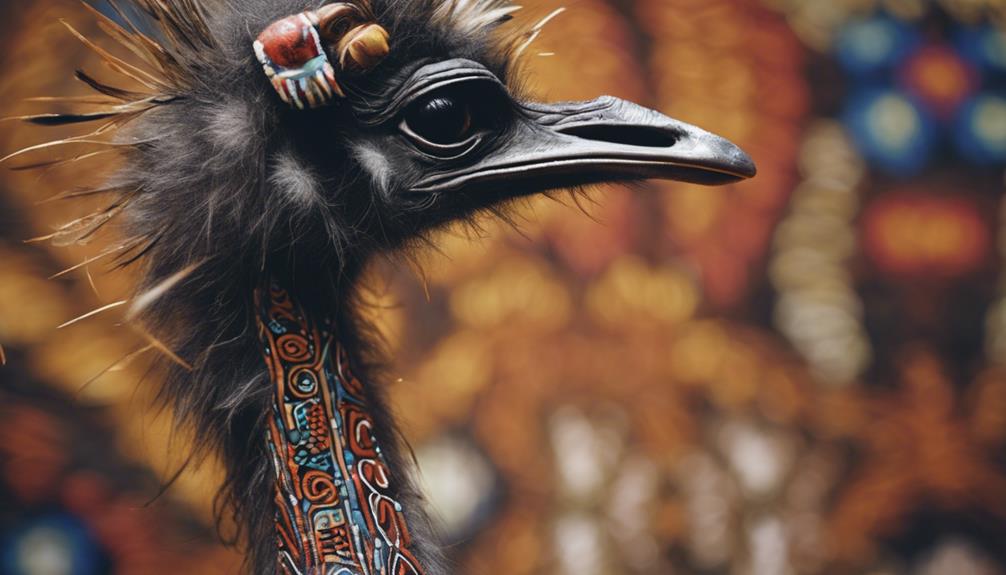
Emu, revered as a totem animal in Aboriginal Australian culture, embodies a sacred connection to ancestral spirits and the natural world. In Indigenous beliefs, the Emu holds significant spiritual importance, serving as a protector and guide for communities across generations.
Here are some intriguing aspects that highlight the role of the Emu as a totem animal:
- Emu as Protector: The Emu is viewed as a guardian spirit, offering protection and watchfulness to those who align themselves with its energy.
- Emu in Ceremonies: During traditional ceremonies, the Emu symbolizes strength, resilience, and a deep connection to the land and ancestors.
- Spiritual Significance: Emus are considered messengers of the Dreamtime, carrying messages between the earthly realm and the spirit world.
- Symbol of Unity: The Emu's presence in rituals and storytelling reinforces the unity between humans, nature, and the supernatural.
Through its symbolism and presence in ceremonies, the Emu stands as a symbol of respect, harmony, and reverence in Aboriginal Australian culture.
Emus in Traditional Medicine
Deeply intertwined with Aboriginal Australian cultural practices, what role do Emus play in traditional medicine among Indigenous communities? Emus hold significant healing properties in traditional Aboriginal medicine. Various parts of the Emu, such as its fat, bones, and feathers, are utilized in medicinal practices. The fat is believed to have potent medicinal uses, often applied topically or ingested for different ailments. Emu bone is sometimes ground into a powder and used in healing ceremonies to promote recovery and strength. Feathers are also incorporated into rituals for their symbolic and spiritual significance in promoting overall wellness.
Healing ceremonies involving Emus are conducted with great reverence and respect for the animal's spirit. These rituals are deeply ingrained in cultural traditions, passed down through generations to promote physical, emotional, and spiritual well-being. The Emu is revered for its resilience and agility, qualities that are believed to transfer to individuals during healing practices. Emus, through their medicinal uses and presence in healing ceremonies, play a vital role in maintaining the health and harmony of Indigenous communities.
Cultural Importance in Songlines
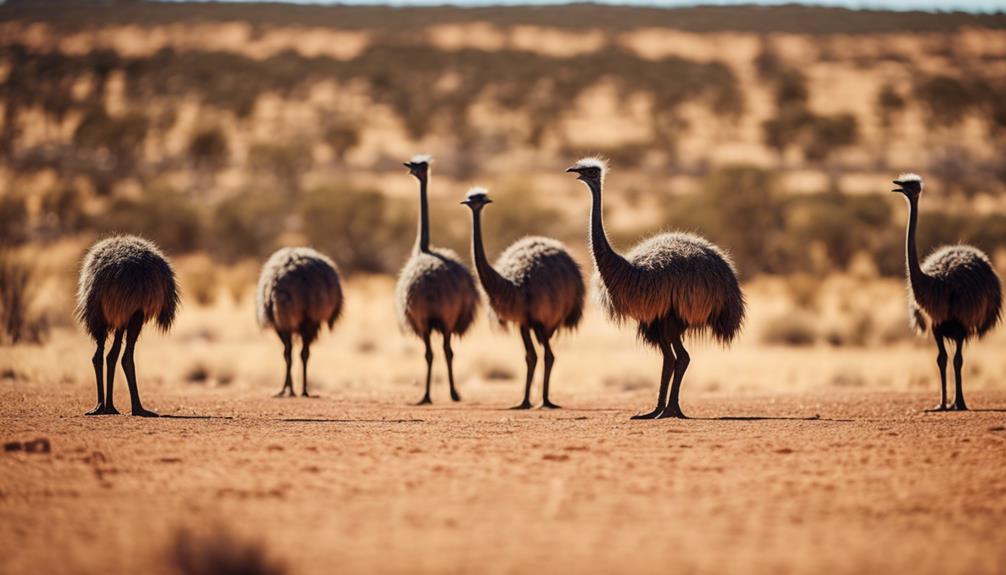
In Aboriginal Australian culture, the concept of Songlines holds profound cultural importance. These intricate pathways of knowledge, passed down through generations, are deeply intertwined with the land, animals, and ancestral stories. Emus play a significant role in these Songlines, reflecting their essence in both migration patterns and breeding habits.
- Emu Migration Patterns: Emus moving across vast stretches of the Australian landscape have long been a part of the Songlines, symbolizing endurance, resilience, and adaptability.
- Emu Breeding Habits: The intricate dance of emu courtship and nesting behaviors is woven into the fabric of Songlines, representing themes of harmony, partnership, and the cycle of life.
Through the lens of Songlines, emus become more than just birds; they transform into messengers of cultural heritage and guardians of ancient wisdom. Their presence in these sacred pathways reflects the deep connection between the Aboriginal people and the natural world, creating a tapestry of meaning that resonates through time.
Emu Conservation Efforts
Efforts to conserve the emu population in Australia have garnered increasing attention from conservationists and researchers alike. Emu breeding programs have been instrumental in safeguarding the future of these iconic birds. By carefully monitoring breeding pairs and creating optimal conditions for reproduction, experts aim to bolster emu numbers and genetic diversity.
Indigenous perspectives on conservation efforts provide valuable insights into emu conservation. Aboriginal Australian communities have long revered the emu as a symbol of resilience and connection to the land. Their traditional knowledge and sustainable practices offer a holistic approach to preserving the emu population. Incorporating Indigenous wisdom into conservation strategies not only benefits the emus but also enriches cultural heritage and fosters collaboration between different knowledge systems.
Emu conservation efforts highlight the importance of balancing modern scientific approaches with traditional ecological knowledge. By embracing both perspectives, conservationists can work towards ensuring the emu's survival for generations to come while honoring its significance in Aboriginal Australian culture.
Frequently Asked Questions
Are Emus Considered Sacred Animals in Aboriginal Australian Culture?
Yes, emus hold a significant place in Aboriginal Australian culture. Their symbolism and spiritual significance are deeply rooted, symbolizing resilience, survival, and connection to the land. Emus are considered sacred animals in this cultural context.
What Role Do Emus Play in Aboriginal Australian Ceremonies and Rituals?
Emus stand as majestic symbols, embodying strength and grace in Aboriginal ceremonies. Their presence infuses traditional practices with deep cultural significance and spiritual meanings. Emu symbolism intertwines with rituals, enriching the spiritual fabric of ceremonies.
How Do Aboriginal Australians Traditionally Interact With Emus in Their Daily Lives?
In traditional Aboriginal life, emu hunting was a vital practice for survival and cultural significance. Emus provided food, feathers for ceremonial use, and their presence in stories and art symbolized connection to the land and ancestral spirits.
Are There Any Specific Taboos or Restrictions Related to Emus in Aboriginal Australian Culture?
In Aboriginal Australian culture, specific taboos and restrictions exist concerning emus. These beliefs influence hunting practices and daily interactions. Understanding and respecting these cultural norms are essential for maintaining harmony and connection with the land and its creatures.
How Have Emus Influenced the Storytelling and Mythology of Aboriginal Australian Communities?
In Aboriginal Australian culture, emus hold a significant place in storytelling and mythology. Their symbolism represents courage, strength, and wisdom. Dreamtime stories often feature emus as powerful beings guiding and teaching important life lessons.
Conclusion
In conclusion, emus play a vital role in Aboriginal Australian culture. They are present in Dreamtime stories and hold spiritual significance as totem animals. Emus are also symbolic in art and traditions. Through dance rituals, traditional medicine, and conservation efforts, emus continue to be an integral part of preserving cultural heritage.
Just like the emu stands tall and proud in the Australian outback, their cultural importance stands firm in the hearts of Aboriginal communities.





